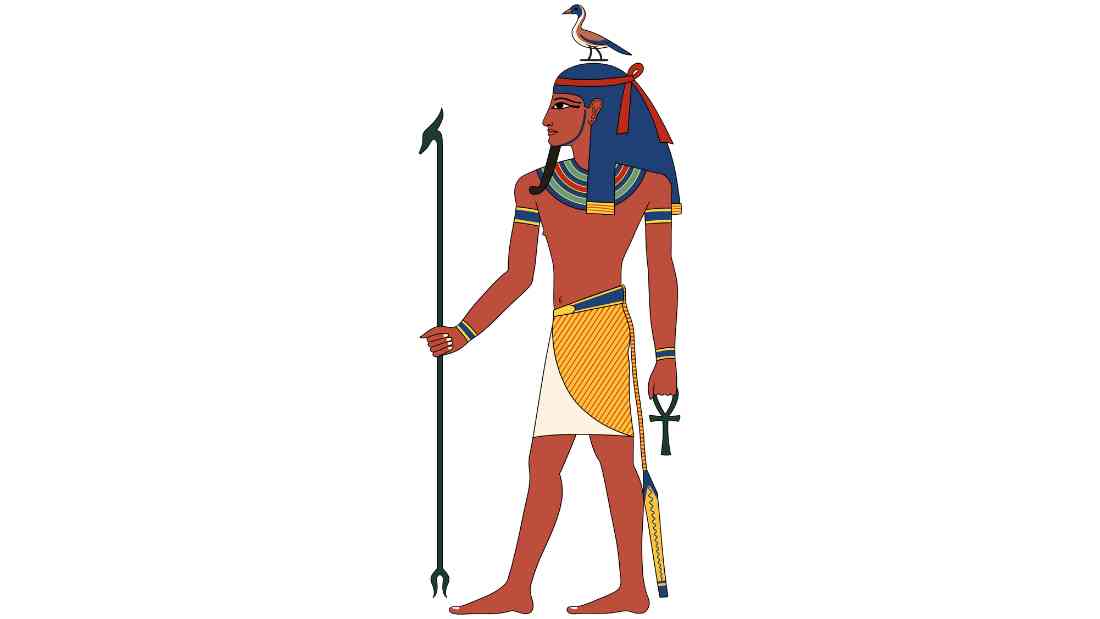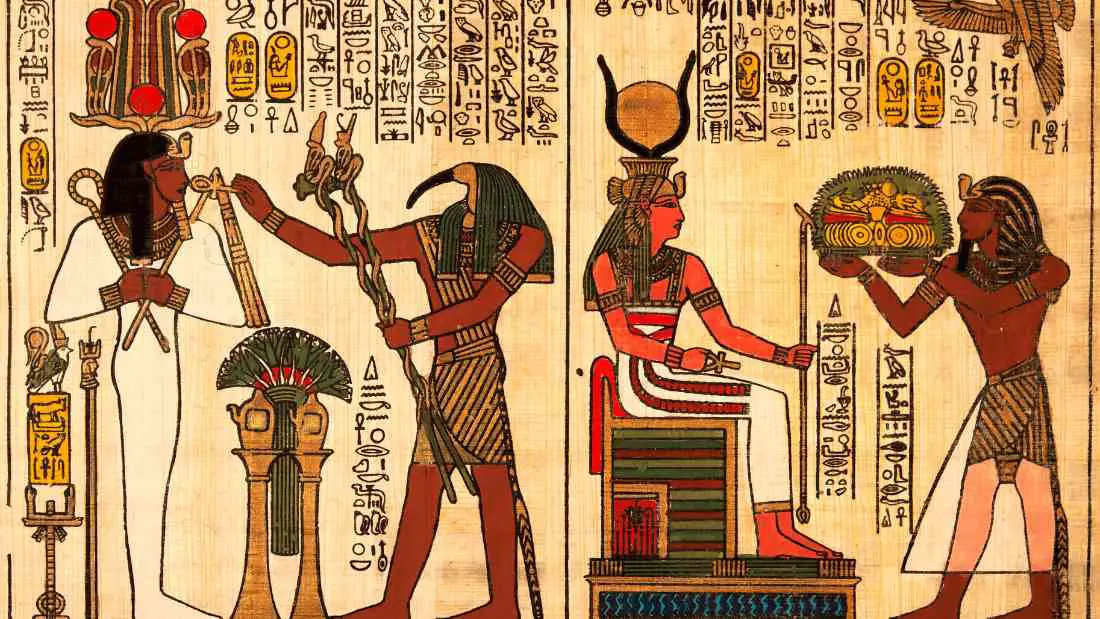The Egyptian god Set, also known as Seth or Sutekh, holds a significant place in the ancient Egyptian pantheon as one of its oldest deities. Believed to be the son of Geb, the god of the earth, and Nut, the goddess of the sky, Set’s lineage ties him closely to the fundamental elements of the natural world.
As the child of Geb and Nut, Set embodies the essence of his parents.
From Geb, Set inherits the groundedness and stability associated with the earth.
He carries within him the power and fertility of the land, representing the vast landscapes that make up Egypt.
This connection to the earth gives Set a sense of authority and dominance over his domain.

On the other hand, Set’s lineage from Nut, the sky goddess, imbues him with qualities of expansiveness and boundlessness.
Just as the sky stretches infinitely above, Set’s influence extends far and wide.
His role as a deity of storms and chaos reflects the untamed and unpredictable nature of the sky, punctuated by thunder and lightning.

The union between Geb and Nut union represents the harmonious balance between the earthly realm and the celestial realm, and the intertwining forces of the earth and the sky.
Set’s existence bridges these two realms, embodying both the terrestrial and cosmic energies. His divine not only grants him immense power but also aligns him with the fundamental forces of creation and destruction.

The Representations of the Egyptian God Set
The representations of Set in ancient Egyptian art and iconography offer fascinating insights into the mythology and symbolism surrounding this enigmatic deity.
Animalistic Appearance
Set is often depicted as a powerful and formidable creature with an animalistic appearance.
While the specific animals vary, common depictions include a mix of dog or jackal-like features.
These animalistic characteristics symbolize Set’s connection to the untamed wilderness and his role as the protector of the desert.
Set’s association with these creatures may also stem from the belief that dogs and jackals were scavengers and lived on the fringes of society, much like the chaotic and unpredictable nature of the desert.

Long Ears
One distinctive feature often seen in depictions of Set is his long ears.
These elongated ears symbolize his acute perception, attentiveness, and ability to detect threats from afar.
Set’s role as a protector required him to be vigilant and aware of any potential dangers lurking in the desert.

Curved Snout
Set is frequently portrayed with a curved snout, resembling the muzzle of a dog or a jackal.
The curved snout represents Set’s predatory nature and his ability to sniff out trouble.
It alludes to his keen sense of smell, which allows him to track down enemies and protect his domain.
Erect Tail
Another notable feature of in some depictions of Set is his erect tail.
The tail is often raised and held vertically, indicating alertness and readiness for action.
Just as a dog’s raised tail signifies attentiveness and readiness to defend, Set’s erect tail represents his vigilance and preparedness to confront any threats to the desert and its inhabitants.
Contrasting Colors
In some artistic representations, Set is portrayed with contrasting colors, such as red hair and black skin.
These contrasting colors are thought to symbolize the duality of Set’s nature, representing both his protective role as well as his association with conflict and chaos.
The representations of Set in ancient Egyptian art showcase the intricate symbolism associated with this deity.
Through his animalistic appearance, long ears, curved snout, erect tail, and contrasting colors, Set embodies the essence of the desert and its inherent chaotic and unpredictable nature.

The Egyptian God Set – Protector of the Desert
The Egyptian desert held a significant place in the collective consciousness of ancient Egyptians.
They held great respect for the desert, recognizing its natural boundaries and its role as a barrier against potential invaders.
The vast stretch of the desert acted as a protective shield, offering a sense of security and marking the borders of Egypt.
However, given its harsh and inhospitable environment, the desert was perceived as a place of chaos and disorder, where the elements themselves seemed to conspire against life.
The Egyptian God Set – Protector Against Chaos and Invaders
It is in this scenario that the figure of Set emerged as a powerful deity, tasked with bringing order and protection to the wide expanses of the desert.
Set was believed to have control over the chaotic forces that roamed the desert, acting as a safeguard against external threats that could arise from this untamed landscape.
The ancient Egyptians viewed him as a formidable defender, embodying the strength and resilience necessary to navigate the challenges posed by the desert’s relentless nature, while also defending the land from external forces.

The Egyptian God Set – A Spiritual Guide
Furthermore, Set’s connection to the desert extended beyond physical protection.
The barrenness and vastness of the desert also symbolized a spiritual journey, representing the trials and tribulations one must face to attain enlightenment.
Set, as the guardian of this transformative landscape, offered support and guidance to those seeking spiritual growth, just as he protected the physical realm from external threats.
The Egyptian God Set – Lord of Conflict
Set’s disruptive and tumultuous nature is highlighted by his role as the bringer of chaos and disorder.
In the otherwise harmonious world of the gods, Set introduced an element of conflict, challenging the established order.
Set and Osiris
One of the most famous stories involving Set centers around his bitter rivalry with his brother Osiris, the god of fertility and the afterlife.
Set’s jealousy and insatiable hunger for power drove him to commit a heinous act – the murder of Osiris.
This act of fratricide sent shockwaves throughout the divine realm, as it was seen as a blatant disruption to the natural balance and harmony that the other gods sought to maintain.

Set’s actions reverberated beyond the world of gods and impacted the mortal realm as well.
The murder of Osiris left a void in the divine order, leading to a struggle for succession and power.
However, amidst the chaos, Osiris’ wife and sister, Isis, known for her wisdom and magical abilities, used powerful magic to bring Osiris back to life for long enough to conceive his son, Horus.
Determined to restore order and justice by ensuring the rightful ascension of Horus to the throne, she protected and nurtured Horus, preparing him for the ultimate confrontation with Set.

The battle between Horus and Set symbolizes the eternal struggle between order and chaos, good and evil.
This epic conflict represented the forces of light and darkness clashing, as Horus sought to avenge his father’s murder and reclaim his rightful place as the ruler of the gods.
The battle itself was fierce and protracted, with both deities utilizing their divine powers and cunning strategies to gain the upper hand.
Ultimately, Horus emerged victorious, embodying the triumph of order and justice over chaos and tyranny.
Set, on the other hand, was condemned to be forever associated with conflict and turmoil, serving as a reminder of the destructive potential that lies within humanity.

The Egyptian God Set – Revered by Soldiers
Set was often invoked in military campaigns, with warriors seeking his favor to inspire courage and ferocity on the battlefield.
His association with conflict and warfare made him a revered deity among soldiers, who believed that his divine guidance would lead them to victory.
Despite his notorious role as the lord of conflict, Set represents the inherent duality of human nature – capable of both good and evil.
Set’s complex persona and his ability to incite conflict also served as a reminder of the importance of balance and the necessity of overcoming destructive impulses.
The Worship of Set
In early Egyptian history, Set was regarded as a positive deity associated with the desert and its fertile aspects.
He was often worshipped alongside other gods and goddesses, particularly in Upper Egypt where he was seen as a protective force against chaos and disorder.
Set was also venerated as a god of strength, courage, and fierceness in battle, and his followers sought his favor to inspire bravery on the battlefield.
However, as time passed and the mythological narrative shifted, the evolving mythological narrative and political climate in ancient Egypt influenced the perception of Set.
The murder of Osiris and Set’s role in it depicted him as a malevolent and treacherous deity, willing to disrupt disrupt the established social and religious order.
This portrayal created a political narrative that was not in the interest of the priests and the upper classes, who wanted to promote stability, order, and the moral authority of the pharaohs.
Thus the ruling elite sought to solidify the power and legitimacy of their rule by focusing on promoting harmony, prosperity, and divine kingship, emphasizing the benevolent aspects of other deities such as Amun-Ra and Osiris.
As a result, Set’s worship gradually declined in popularity, especially during the New Kingdom period when other gods gained more prominence.

Final Thoughts on the Dual Role of the Egyptian God Set
Set’s dual role as the protector of the desert and the lord of conflict holds symbolic significance within Egyptian mythology.
The desert, with its harshness and unpredictability, represents the challenges and obstacles that individuals face in their lives.
Set’s role as protector signifies the need to confront and overcome these challenges, embracing the chaos and disorder as a catalyst for growth and strength.
Similarly, Set’s association with conflict serves as a reminder that balance cannot be achieved without acknowledging and addressing the inherent contradictions and conflicts that exist within the human experience.

Frequently Asked Questions About The Egyptian God Set
Set is an ancient Egyptian god associated with conflict, chaos, and disruption. He was often depicted as a mythical creature resembling a composite of different animals, including a canine or feline body with squared ears and a long snout.
Set is commonly represented with distinctive features such as an animal head with squared ears, an erect tail, and sometimes a forked tail. He is often shown holding a scepter or ankh, emphasizing his divine authority and power.
Set’s role in mythology varies across different periods and regions. Initially, he represented positive aspects such as strength, deserts, and protection against chaos. However, later narratives portray him as a malevolent force responsible for killing his brother Osiris and challenging the established order.
Set’s rivalry with Horus reflects the struggle between chaos and order in Egyptian mythology. Their battles symbolize the eternal conflict between good and evil, light and darkness, and the constant need to maintain cosmic balance.
Set’s association with conflict, chaos, and betrayal made him less favorable among the ruling class during the New Kingdom period. The pharaohs and priests sought to promote a more harmonious and stable worldview by elevating other deities like Amun-Ra and Osiris.
Posts About the Egyptian Pantheon of Gods
The Pantheon of Ancient Egyptian Gods – A Comprehensive Guide
The Wrath of Montu – The Mythology of the Egyptian War God
Egyptian God Ammit – The Eater of Hearts in Ancient Egyptian Mythology
The Nightly Journey of Khonsu – The Ancient Egyptian God of the Moon
Ihy – The Joyful Ancient Egyptian God of Music
Min – The Ancient Egyptian God of Fertility
The Egyptian God Anubis – His Evolution from Son of Ra to Protector of the Dead
Unraveling the Mysteries of Babi – The Ancient Egyptian Baboon God
Ra, the Egyptian Sun God – Symbolism and Significance in Ancient Egyptian Culture
Sobek: The Ferocious Crocodile God of Ancient Egypt
The Enigmatic Mythology of Horus, the Egyptian Sky God
The Egyptian God Set – Protector of the Desert and Lord of Conflict
The Ancient Egyptian God Medjed: The Guardian of Osiris and the Afterlife
Anput, the Wife and Female Version of Anubis
Selket – The Scorpion Crowned Egyptian Goddess
Shu – The Egyptian God of Air, Wind, Peace and Lions
Hapi the Androgynous Ancient Egyptian God of the Nile
The Egyptian Sky Goddess Nut: Myth and Symbolism
The 42 Laws of Maat: The Moral Principles of the Ancient Egyptians
The Ancient Egyptian Goddess Mut: The Maternal Power in Egyptian Mythology
The Warrior Goddess: Neith in Ancient Egyptian Mythology
The God Bes: The Joyful Dwarf Deity in Ancient Egyptian Culture
The Egyptian Gods of Love: Hathor and Isis in Ancient Egyptian Mythology
Confronting the Serpent: The God Apep, the Nemesis of Ra in Egyptian Myth

